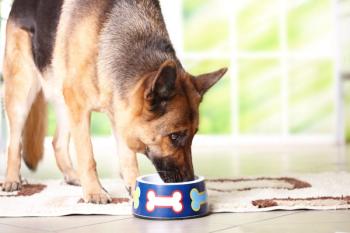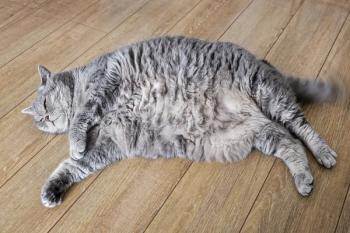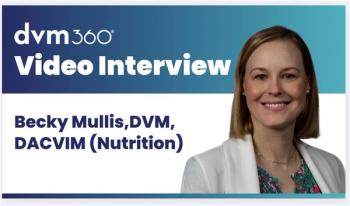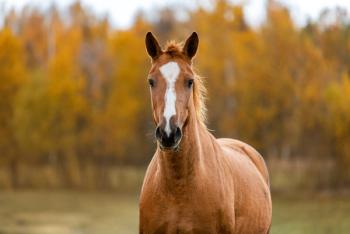
Obesity: the skinny on fat (Proceedings)
Obesity is the most important malnutrition of companion animals. It can be a disabling medical condition when moderate to severe in scope. At prevalence rate estimates of 10-40%, obesity must be considered a significant hazard to dogs and cats.
Obesity is the most important malnutrition of companion animals. It can be a disabling medical condition when moderate to severe in scope. At prevalence rate estimates of 10-40%, obesity must be considered a significant hazard to dogs and cats. Increased emphasis on pet health and preventative health programs makes obesity prevention an important aspect of health maintenance programs in dogs and cats. Treatment for obesity varies from frustrating to rewarding and evaluating and prescribing for successful, long term weight loss and maintenance usually requires management of multiple, inter-related patient and client factors. Diagnosis of disease secondary to obesity and the major task of client education and motivation is the provenance of the veterinarian.
Definition
Obesity is a condition of positive energy balance and excess adipose tissue accumulation with adverse effects on quality and quantity of life. Obesity literally means increased body fatness, but measurement of fat fractions of body composition is difficult in practice. Therefore, obesity can be defined as body weight in excess of 15 to 20 % of ideal, due to the accumulation of body fat. Negative health manifestations often begin at this level of weight excess and are a virtual certainty at a 30% excess over ideal weight.
Pathogenesis of body fat composition
Pathogenesis of obesity is not as simple and direct as uncontrolled gluttony. The idea of human obesity as a syndrome caused by being "weak in will" has yielded to observations and reasoning that obesity is a complex disorder of metabolism and satiety control with significant genetic components. Multiple genetic and environmental factors control regulation of food intake, resting metabolic rate, thermic effect of food, and energy expenditure and efficiency during work. Three causes of initial obesity in pets are overeating, decreased exercise, and lower metabolic rate; however, genetic influence cannot be overlooked.
Risk factors for obesity
Gender is important in the development of adult obesity; females or neutered animals are more frequently affected with obesity than males or intact animals. In addition to gender, certain breeds are predisposed to developing obesity while other breeds appear to be resistant. Pet owner lifestyle is important, as overweight human beings are more likely to own an overweight pet. Apparently overweight owners provide opportunities that override normal internal and external satiety control signals for both themselves and their pets. Ad libitum feeding, improper meal feeding, inappropriate diet selection, supplementation, provision of home cooking, and the conditioning of abnormal feeding behavior all cause excess calorie consumption. Begging, competitive eating with other pets and specific food addictions are problems in some homes and are identifiable risk factors.
Body fat deposition
Body composition of 1-2% fat at birth increases rapidly to 10-15% by weaning at 4-6 weeks, and is 15-20% in normal dogs during the first year of maturity. Females have increased levels when compared with males. Twenty-five to 30% fat is normal in dogs 8-10 years of age as there is lower lean body mass and increased adiposity with ageing. The initial phase of obesity occurs during chronic, positive energy balance. A phase of static obesity follows when caloric expenditure equilibrates with intake and the animal maintains a stable, but altered body composition of increased adipose tissue. These phases may repeat many times during an animal's life leading to a gradual step-wise increase in body weight and body composition. Because fat-free mass appears to be an important determinant of resting energy, as more fat mass is acquired and as lean mass is lost, less energy intake is required to maintain the increased body weight (increasing fat mass). This explains why many obese animals do not appear to be eating "too much" or why owners often say "but my dog only eats a half of a cup of food a day".
Detrimental effects of obesity
Obesity is associated with many diseases and has been shown to decrease life span in dogs and cats. Obese pets generally appear less healthy and have a less pleasing appearance. Furthermore, obese animals have less tolerance to heat and environmental changes. With added weight in obesity, physical activity is often decreased. This may not only make for an acceptable pet, but inactivity may also potentiate the weight gain because of decreasing the resting energy requirement. Obesity is associated with increased risk for musculoskeletal disease such as degenerative osteoarthritis, intervertebral disc disease, and anterior cruciate rupture, and in growing large breed dogs, excessive energy intake and obesity may lead to developmental musculoskeletal disease such as hip dysplasia, osteochondrosis desiccans, and joint laxity and deformity. In dogs, obesity has been shown to be associated with increased blood pressure. Excess thoracic fat and increased liver size may impair ventilation, decrease respiratory efficiency, and result in alveolar hypoventilation. Treatment of collapsing trachea is improved with weight reduction. With increasing adiposity, lipid infiltrates the liver and in cats may result in liver failure due to hepatic lipidosis if a stressful event resulting in anorexia occurs. In breeding animals, obesity causes decreased sperm viability due to decreased testosterone production, and in females, it predisposes them to dystocia. Bacterial infections were also more severe in obese dogs than in dogs of normal weight. Obesity has been associated with increased skin and gastrointestinal disease in dogs and cats. It may represent overall decrease in body condition, decrease in general health, decrease in immunocompetence, and intake of an unbalanced diet. When surgery is necessary in obese animals, a compromised surgical approach, general difficulty in dissection, and increased incidence of intraoperative and postoperative complications can be expected. Obesity predisposes to local infection and some surgeons consider using antibiotic prophylaxis even in clean surgical procedures performed on obese animals. Obese animals are more difficult to achieve an adequate anesthetic state because of decreased hepatic metabolism, compromised respiratory and cardiovascular function, and because of redistribution of drugs into adipose tissue. Obesity not only interferes with surgical procedures, but diagnostic procedures as well such as thoracic auscultation and abdominal palpation. Obesity is associated with an increased risk of certain types of cancer. Obesity is associated with insulin receptor defect(s) and decreasing sensitivity to insulin fat, muscle, and liver. Insulin resistance and hyperglycemia occur concurrently as fatty acids displace glucose as the preferential fuel source. While the obese, type II diabetic animal is not dependent on exogenous insulin for maintaining the non-ketotic state, there is both a fasting hyperglycemia and abnormal glucose tolerance test response. Non-insulin dependent diabetes mellitus caused by obesity may be reversible by weight loss in some cats. Obesity decreases longevity in pets.
Diagnosis of obesity
The diagnosis of obesity is often obvious on clinical inspection and palpation of the patient. The differential diagnosis for obesity includes pregnancy, peripheral edema, intra-abdominal organomegaly, abdominal masses, ascites, hypothyroidism, and hyperadrenocorticism. Quantification of obesity requires the use of objective methods, but the convenient measurement of body composition is not practical in practice settings. Therefore, indirect methods are substituted and their limitations accepted.
Body weight
Body weight can be an indirect measurement of obesity in pets and it is a procedure that is familiar, easily determined, and universally available. The dog's weight at its first birthday or during the first year of maturity probably reflects the "ideal" adult weight if skeletal development and juvenile nutrition are normal. Another useful generalization from weight measurement is that the mature domestic cat weighs 3.5-5.0 kg (8-11 lb) at a normal body composition. The major disadvantage of using body weight as a standard for body composition is that "overweight" may not mean "overfat". This is true in athletic or working animals. Breed weight tables serve as guidelines for diagnosis in individual patients. Normal intra-breed body weight and height variability, determining ancestry in mixed breed animals, and the lack of statistically validated age- and gender-specific adjustment factors to the purebred dog averages are the major limitations in using weight tables too literally.
Body condition score
Subjective clinical observations for obesity assessment are the loss of an "hourglass" shape when viewed from above, protuberant or draped accumulations of fat around the tailhead and neck, and the inguinal "udder" in cats. Different fat accumulation patterns are specific for men versus women and are predictive for cardiovascular disease risks in human beings. Such patterns are of attenuated diagnostic importance in the companion animal. Inability to easily distinguish the individual ribs by palpation means that excess subcutaneous fat is present. This is a practical means of physical diagnosis, but may under-diagnose obesity if there are substantial, localized fat accumulations elsewhere. A 5-point and 9-point scale have been published. The middle of the scale represents optimal condition; lower values represent various degrees of under-conditioning and higher values represent various degrees of 'over-conditioning'.
Treatment of obesity
Treatment of obesity requires a team effort and convincing the client to be a part of the solution and not part of the problem. Set a goal for the clients and stick to it. Giving positive feedback even if the success is small is very important and helps to support the client in their effort to not only change habits, perhaps long-standing, in their pets, but in themselves as well. When possible, a combination of dietary therapy and exercise is effective. This is difficult in dogs that have pre-existing orthopedic problems and in cats.
Diet
There are basically five dietary options available for the management of obesity. The first option is feed lesser amounts of the same diet. While this has the advantage of allowing the owner to purchase and feed the same diet, many times the pet will develop habits of begging or of scavenging for food. It is thought that the pet experiences a feeling of hunger because of this technique. Furthermore, owners often feel guilty because their pet appears to be constantly hunger, and many times their perception is that a "healthy pet is a full pet". The second option is starvation. Starvation results in rapid weight loss; however, initial losses are often due to changes in water content of the body. This is a very dangerous technique and requires the animal to be hospitalized. As a result, owners are not part of the effort. This is an especially dangerous technique in cats because obese cats that suddenly stop eating are at risk for developing hepatic lipidosis and failure. The third option is to feed a low carbohydrate containing diet. The idea is that by limiting carbohydrate intake and providing protein, vitamins, minerals, and fat, the body begins to mobilize peripheral fat for energy. This strategy works in some cats, but not all, and has not been shown to be effective yet in dogs. The fourth option utilizes a high protein diet. In human beings, this is usually a liquid diet. This type of weight loss diet is not utilized anymore because of fatalities associated with electrolyte and mineral imbalances. Lastly, substituting "empty calories" for digestible calories can decrease the caloric content of the diet. A safe and effective formulation must provide for complete nutrition and nutrient balance in relation to dry matter intake. There must be complete bioavailability of all nutrients except energy. Using unbalanced diets in weight reduction programs may produce deficiency states that can be dangerous or lethal. Replacing dietary fat with indigestible fiber creates a hypocaloric diet. Fiber reduces the caloric density of the diet by physically insulating nutrients from digestive enzymes, and reducing food transit time. The reduced total and energy digestibility of a high fiber diet requires offsetting increases in protein and micronutrients to compensate for the diet's reduced digestibility. Because the patient is treated with a low fat, high fiber diet, it is able to ingest familiar volumes of dry matter and dietary bulk and neuroendocrine responses to mechanical and chemical gastrointestinal fullness are retained as contributory signals to the satiety center. Hyperphagia and begging are less frequent. Whether high fiber diets in fact induce satiety is controversial. There are also "low fiber" diets available for weight management. Although the crude fiber content is perhaps low, the types of fiber that are used in these diets are not analyzed by the crude fiber method; therefore, the un-measured fiber is reported as part of the carbohydrate (NFE) fraction. Dietary fiber is defined as chemically and morphologically diverse plant substances resistant to hydrolysis by digestive enzymes including plant cell wall substances (cellulose, hemicellulose, pectin, and lignin) as well as intracellular polysaccharides (gums and mucilages). Fiber can be classified based on solubility or fermentability, and each imparts different physiological effects. There are several diets that are manufactured and marketed for weight reduction. Usually these diets are higher in fiber.
There are two techniques that are available for weight reduction in pets. The first uses an estimation of the ideal weight, and the second uses a target goal of weight loss per week and monitoring and adjusting dietary intake to meet this goal (iterative approach).
Using ideal weight
Using this technique, an ideal weight for the animal is estimated. The maintenance energy requirements for that animal are estimated using the ideal weight. In order to induce weight reduction, it is necessary to restrict caloric intake further, to approximately 60-75% of the maintenance energy requirement calculated using the ideal body weight. Different pet food companies recommend different percentages, and they range from 40% to 80%. At least 2 studies show that in dogs, using 75% of maintenance energy requirement results in a 1-2% rate of weight loss per week and minimizes rebound weight gain once the target weight is reached and the diet is changed to a maintenance diet.
A weight reduction diet is chosen, typically a high fiber/low fat diet or a low carbohydrate diet if a cat, and the amount to feed to meet this calculated weight loss goal is determined by dividing the MER for weight reduction by the caloric content of the diet. The diet is gradually changed over 5-7 days to avoid inducing gastrointestinal upsets such as vomiting, diarrhea, and inappetence. Following this period, the pet should be weighed every 2 weeks and the body weight charted. This accomplishes several things. First, it provides graphical representation of the weight loss period. Secondly, it provides encouragement for the owner. Once the target weight is reached, the diet can be switched from a weight loss diet to a diet designed for weight maintenance.
Iterative process
Using this technique, the ideal weight is not estimated. Rather, a target rate of weight loss is estimated, and a weight loss diet is fed to achieve this rate. For example, a target rate of 2% loss of body weight per week may be chosen. The amount of a weight loss diet to feed in order to induce this 2% loss of body weight is then calculated, and the diet is slowly switched. The pet is returned every 2 weeks and the food intake is adjusted to continue this controlled rate of weight loss. A computer program developed by Ralston Purina Company is available to facilitate using this technique.
Pharmacologic treatment
Dehydroepiandrosterone (DHEA) is an agent that has been evaluated in dogs, and is not effective. Recently, Slentrol (dirlotapide), a selective microsomal triglyceride transfer protein inhibitor that blocks assembly and release of lipoproteins into the bloodstream, has been approved by the FDA to decrease weight in dogs. Its primary mechanism of action is decreasing appetite; however, a slight decrease in fat absorption also occurs. The drug is given to the dog in varying amounts over the course of the treatment. The dog is given an initial dose for the first 14 days. After that, assess the dog's progress at monthly intervals, adjusting the dose depending on the dog's weight loss. After the dog has achieved the goal weight, the drug is continued during a three-month period, while the the optimal level of food intake and physical activity needed to maintain the dog's weight is established. Adverse reactions associated with treatment with Slentrol include vomiting, loose stools, diarrhea, lethargy and loss of appetite.
Surgery
Several surgical techniques are employed in human beings including jejunoileal bypass, gastrectomy or gastric stapling, and jaw wiring. Additionally, liposuction is utilized to decrease peripheral adipose stores. These techniques have not been evaluated in dogs and cats.
Prevention
In order to prevent obesity, it is necessary to modify risk factors that led to obesity in the first place. This involves altering behaviors of not only the pet, but of the owners as well. In animals that have difficulty in keeping weight off, diets are available that are less calorically dense, contain higher fiber content, and are complete and balanced for maintenance (see table of diets). Animals that are high risk for recurrence of obesity should be evaluated periodically. Examination should involve not only a good physical examination, but also measurement of body weight, and estimation of body condition using a body condition score. This can be accomplished as part of an overall health maintenance plan. This allows the veterinarian to recommend changes that may aid in preventing obesity from recurring. Also, it establishes a good patient-client-doctor relationship. Owners require positive re-enforcement for doing a good job and a gentle "push in the right direction" if their pet is beginning to gain weight back.
Snacks may be an important part of development and maintenance of obesity. Therefore, they should be used sparingly. If used, they should not represent more than 5% of energy intake, and they must be accounted for in estimation of dietary intake necessary to meet maintenance energy requirements. Because "snacking" is a large part of human existence, it is difficult to break owners of this habit. Instead of punishing owners for giving snacks to their pets, in which case they may be dishonest about providing such treats, it is better to counsel them on what treats and what amount is acceptable.
Top 10 excuses clients give for not managing a pet's weight. – NAVC clinician's brief – Jan, 2007
1. No one outlined a weight loss program before: "I was told she should lose weight, but I don't know what to do."
2. Metabolism changes: "But I don't feed him any differently than before."
3. Unable to exercise pet: "I just don't have the time to walk her."
4. Feeding is a bonding experience: "But we look forward to treat time."
5. Other people feed pet: "When I'm at work, my mom overfeeds him."
6. Previous weight loss plan failure: "She doesn't like the diet food and nothing seems to work."
7. Pet appears hungry: "But I feel like I'm starving him and he's always begging."
8. Multiple-pet household: "She eats her brother's food. What can I do?"
9. Do not see benefit of weight loss: "So what's a little extra weight? I love him the way he is."
10. Do not view pet as overweight: "She looks okay to me."
Nine tips to improve obesity management – Laflamme, 2000
1. Use a body condition scoring system
2. Diagnose obesity
3. Utilize effective 2-way communication
4. Use support staff
5. Be flexible & individualize treatment
6. Recognize the human-animal bond
7. Follow-up with clients
8. Reward success
9. Use photographs
Newsletter
From exam room tips to practice management insights, get trusted veterinary news delivered straight to your inbox—subscribe to dvm360.






